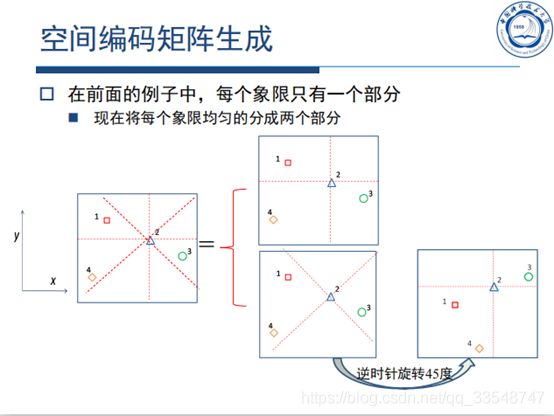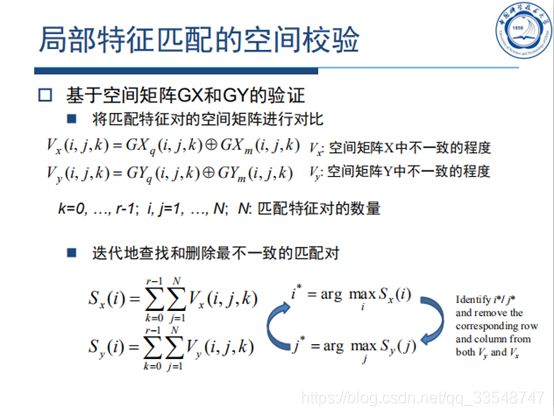DIA实验——匹配几何校验
匹配几何校验
一、 任务描述
- 给定一对图像,利用提取好的SIFT特征文件,根据距离阈值准则(跨图像的局部SIFT特征距离小于0.4),得到图像间的初始局部特征匹配关系;
- 基于上述初步匹配结果,实现spatial coding方法,进行匹配校验,确定几何不一致的匹配;
- 将几何一致的匹配和不一致的匹配在图像上画出来,分别用蓝色和红色进行区分。
二、 实验步骤
- 寻找匹配对:寻找并提取第1张图与第2张图的SIFT描述子匹配对的(x,y)坐标点集,分别放进维数为(2*对应点数)的矩阵Map1,Map2中。
- 生成空间映射:根据Map1,Map2每个点相对其他点坐标的左右上下位置关系,以及k种(本实验中取k=4)旋转角度,生成由0、1构成的维数为(对应点数对应点数k)的空间编码矩阵GX1,GY1,GX2,GY2中。
- 计算不一致性矩阵:将空间编码矩阵GX1与GX2,GY1与GY2进行逻辑异或操作得到不一致性矩阵Vx,Vy。
- 计算不一致性总和Sx,Sy: 矩阵Vx,Vy各行元素求和,再对k个方向各行元素和求总和,得到Sx,Sy,维数为(匹配点数*1)
- 检查Sx,Sy,识别错误匹配项:首先基于Vx,计算Sx,找到对应的i*, 然后从Vx和Vy中把对应的第i行、第i列全部删掉(或者mask掉,本实验中以置零方式进行mask),随后立即更新红蓝连线;然后基于更新后的Vy,计算Sy,找到对应的j*, 然后从Vx和Vy中把对应的第j行、第j列全部删掉(或者mask掉,本实验中以置零方式进行mask),随后立即更新红蓝连线。 对更新后的Vx和Vy重复上面两步,直到收敛(本实验取不一致性总和的阈值为(0.8*匹配对数)取整)。
三、 实验效果
四、 实验代码
其中本实验对图像特征描述子的读取通过已准备好的“.sift”文件直接读进matlab中,也可以自己在matlab中读取“.jpg”图片后转为SIFT格式的描述子数据,matlab代码如下:
%% Set path and parameters
clear;
close all;
clc;
src_1 = './test images/37967br1.jpg';
src_2 = './test images/791.jpg';
% src_1 = './test images/4.jpg';
% src_2 = './test images/Apollo-266.jpg';
% src_1 = './test images/771.jpg';
% src_2 = './test images/305.jpg';
% src_1 = './test images/Apollo-49.jpg';
% src_2 = './test images/Apollo-266.jpg';
ext = '.sift'; % extension name of SIFT file
siftDim = 128;
maxAxis = 400;
%% Load image
im_1 = imread(src_1);
if max(size(im_1)) > maxAxis
im_1 = imresize(im_1, maxAxis / max(size(im_1)));
end
im_2 = imread(src_2);
if max(size(im_2)) > maxAxis
im_2 = imresize(im_2, maxAxis / max(size(im_2)));
end
%% Load SIFT feature from file
featPath_1 = [src_1, ext];
featPath_2 = [src_2, ext];
fid_1 = fopen(featPath_1, 'rb');
featNum_1 = fread(fid_1, 1, 'int32');
SiftFeat_1 = zeros(siftDim, featNum_1);
paraFeat_1 = zeros(4, featNum_1);
for i = 1 : featNum_1
SiftFeat_1(:, i) = fread(fid_1, siftDim, 'uchar');
paraFeat_1(:, i) = fread(fid_1, 4, 'float32');
end
fclose(fid_1);
fid_2 = fopen(featPath_2, 'rb');
featNum_2 = fread(fid_2, 1, 'int32');
SiftFeat_2 = zeros(siftDim, featNum_2);
paraFeat_2 = zeros(4, featNum_2);
for i = 1 : featNum_2
SiftFeat_2(:, i) = fread(fid_2, siftDim, 'uchar');
paraFeat_2(:, i) = fread(fid_2, 4, 'float32');
end
fclose(fid_1);
%%Normalization
SiftFeat_1 = SiftFeat_1 ./ repmat(sqrt(sum(SiftFeat_1.^2)), size(SiftFeat_1, 1), 1);
SiftFeat_2 = SiftFeat_2 ./ repmat(sqrt(sum(SiftFeat_2.^2)), size(SiftFeat_2, 1), 1);
%% Check match based on distances between SIFT descriptors across images
normVal = mean(sqrt(sum(SiftFeat_1.^2)));
matchInd = zeros(featNum_1, 1);
matchDis = zeros(featNum_1, 1);
validDis = [];
gridDisVec = [];
ic = 0;
for i = 1 : featNum_1 %以第一张图描述子数量为基准进行匹配
tmpFeat = repmat(SiftFeat_1(:, i), 1, featNum_2); % repmat(A,m,n),将矩阵 A 复制 m×n 块,即128*featNum_2
d = sqrt(sum((tmpFeat - SiftFeat_2).^2)) / normVal; % L2 distance,图1第i个描述子与图2所有描述子的距离向量
matchDis(i) = min(d);
[v, ind] = sort(d);
if v(1) < 0.4 % 最小距离小于0.4,则认为构成一对匹配
matchInd(i) = ind(1);
ic = ic + 1;
validDis(ic, 1 : 3) = [v(1), v(2), v(1) / v(2)];
tmp = (SiftFeat_1(:, i) - SiftFeat_2(:, ind(1))).^2;
tmp2 = reshape(tmp(:), 8, 16);
gridDisVec(ic, 1 : 16) = sqrt(sum(tmp2)); % 第ic个匹配描述子的L2距离
end
end
figure; stem(matchDis); ylim([0, 1.2]); %绘制茎状图
figure; stem(matchDis(matchInd > 0)); ylim([0, 1.2]);
%% 实现spatial coding方法,进行匹配校验准备
Map1 = [];
Map2 = [];
m= 1;
for i = 1 : featNum_1
if matchInd(i) > 0
Map1 = [Map1, paraFeat_1(1:2, i)];
Map2 = [Map2, paraFeat_2(1:2, matchInd(i))];
end
end
% xys = paraFeat_1(:, i);
% xys2 = paraFeat_2(:, matchInd(i));
r = 4;
GX1(ic, ic, r) = 0;
GY1(ic, ic, r) = 0;
GX2(ic, ic, r) = 0;
GY2(ic, ic, r) = 0;
for k = 1:r
%将其分解为r个独立的子区域,旋转k个单位的坐标集
theta = (k-1)*pi/(2*r);
G1(1:2, 1:ic, k) = [cos(theta), -sin(theta); sin(theta), cos(theta)]*Map1;
G2(1:2, 1:ic, k) = [cos(theta), -sin(theta); sin(theta), cos(theta)]*Map2;
%获取空间编码01矩阵
for i = 1:ic
for j = 1:ic
if G1(1, i, k) >= G1(1, j, k)
GX1(j, i, k) = 1;
end
if G1(2, i, k) >= G1(2, j, k)
GY1(i, j, k) = 1;
end
if G2(1, i, k) >= G2(1, j, k)
GX2(j, i, k) = 1;
end
if G2(2, i, k) >= G2(2, j, k)
GY2(i, j, k) = 1;
end
end
end
end
Vx = xor(GX1, GX2);
Vy = xor(GY1, GY2);
%% Show the local matching results on RGB image
[row, col, cn] = size(im_1);
[r2, c2, n2] = size(im_2);
imgBig = 255 * ones(max(row, r2), col + c2, 3);
imgBig(1 : row, 1 : col, :) = im_1;
imgBig(1 : r2, col + 1 : end, :) = im_2;
% np = 40;
% thr = linspace(0,2*pi,np) ;
% Xp = cos(thr);
% Yp = sin(thr);
paraFeat_2(1, :) = paraFeat_2(1, :) + col; %为了让两幅图画面并排,使右侧图x坐标右移col个单位
figure(3); imshow(uint8(imgBig)); axis on;
hold on;
matchCount = 0;
for i = 1 : featNum_1
if matchInd(i) > 0
matchCount = matchCount + 1;
xys = paraFeat_1(:, i);
xys2 = paraFeat_2(:, matchInd(i));
figure(3);
% hold on;
% plot(xys(1) + Xp * xys(3) * 6, xys(2) + Yp * xys(3) * 6, 'r'); %图1匹配描述子红圈
% plot(xys2(1) + Xp * xys2(3) * 6, xys2(2) + Yp * xys2(3) * 6, 'r'); %图2匹配描述子红圈
hold on; plot([xys(1), xys2(1)], [xys(2), xys2(2)], '-b', 'LineWidth', 0.8);
end
end
%% 几何匹配校验
Map2(1, :) = Map2(1, :) + col; %为了让两幅图画面并排,使右侧图x坐标右移col个单位
threshold = floor(ic*0.8);
for i = 1:ic
Sx = sum(sum(Vx, 2), 3); %矩阵各行元素求和,再对k个方向各行元素和求总和
[Cx, Ix] = max(Sx(:, :), [], 1); %求出第k个方向的列最大值
if Cx>threshold
Vx(Ix, :, :) = 0; %把最不匹配的描述子mask
Vx(:, Ix, :) = 0;
Vy(Ix, :, :) = 0; %把最不匹配的描述子mask
Vy(:, Ix, :) = 0;
hold on;plot([Map1(1, Ix), Map2(1, Ix)], [Map1(2, Ix), Map2(2, Ix)], '-r', 'LineWidth', 0.8); %不匹配的描述点对连线
end
Sy = sum(sum(Vy, 2), 3); %矩阵对各行元素求和
[Cy, Iy] = max(Sy(:, :), [], 1);
if Cy>threshold
Vx(Iy, :, :) = 0; %把最不匹配的描述子mask
Vx(:, Iy, :) = 0;
Vy(Iy, :, :) = 0; %把最不匹配的描述子mask
Vy(:, Iy, :) = 0;
hold on;plot([Map1(1, Iy), Map2(1, Iy)], [Map1(2, Iy), Map2(2, Iy)], '-r', 'LineWidth', 0.8); %不匹配的描述点对连线
end
end
figure(3);
title(sprintf('Total local matches : %d (%d-%d)', length(find(matchInd)), featNum_1 ,featNum_2));
hold off;
五、参考文献
代码及资料
Wengang Zhou, Yijuan Lu, Houqiang Li, Y. Song, and Qi Tian, “Spatial coding for large scale partial-duplicate web image search,” ACM International Conference on Multimedia (MM), pp.131-140, 2010.








